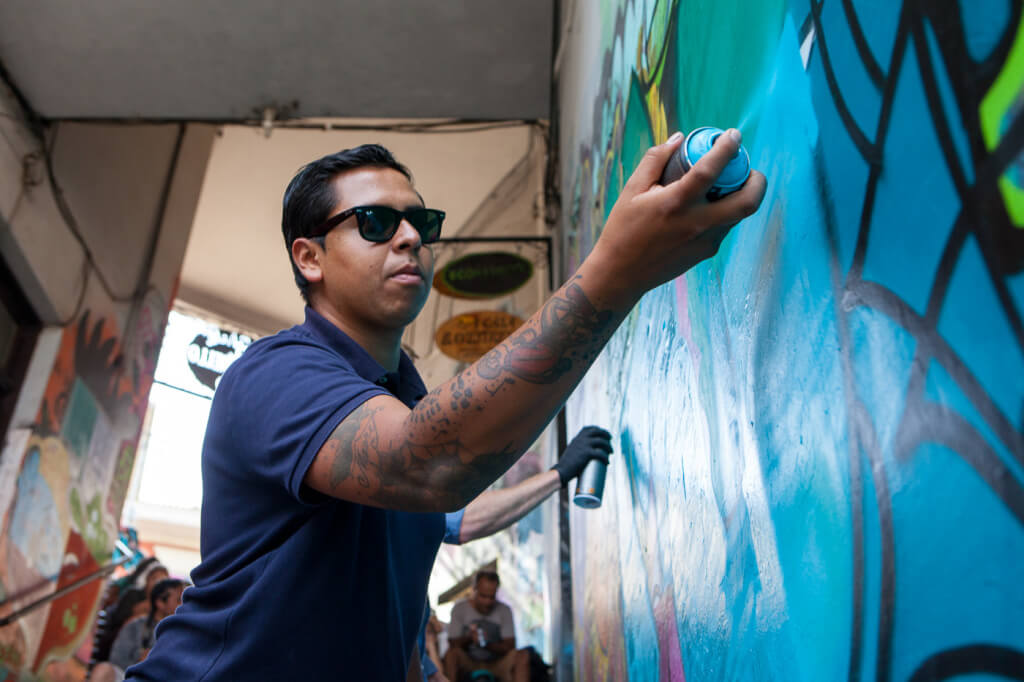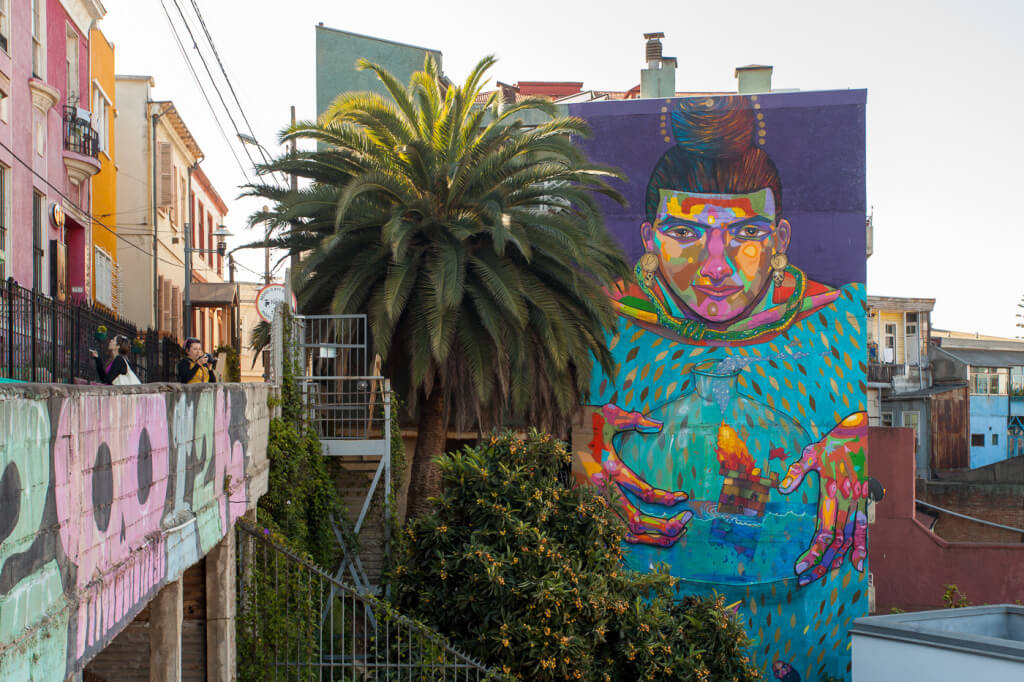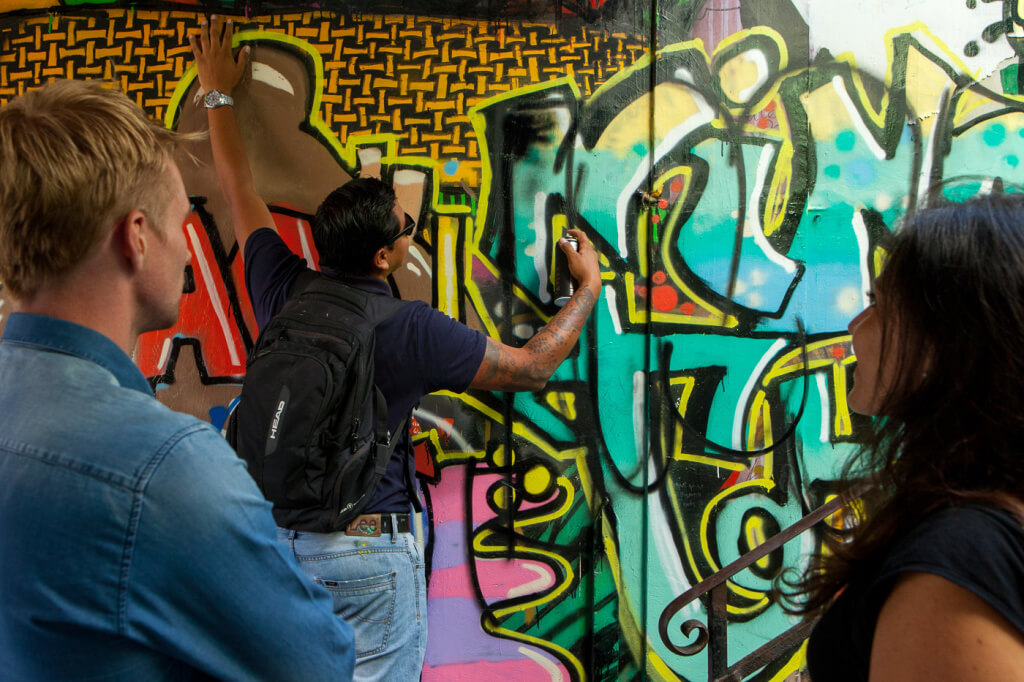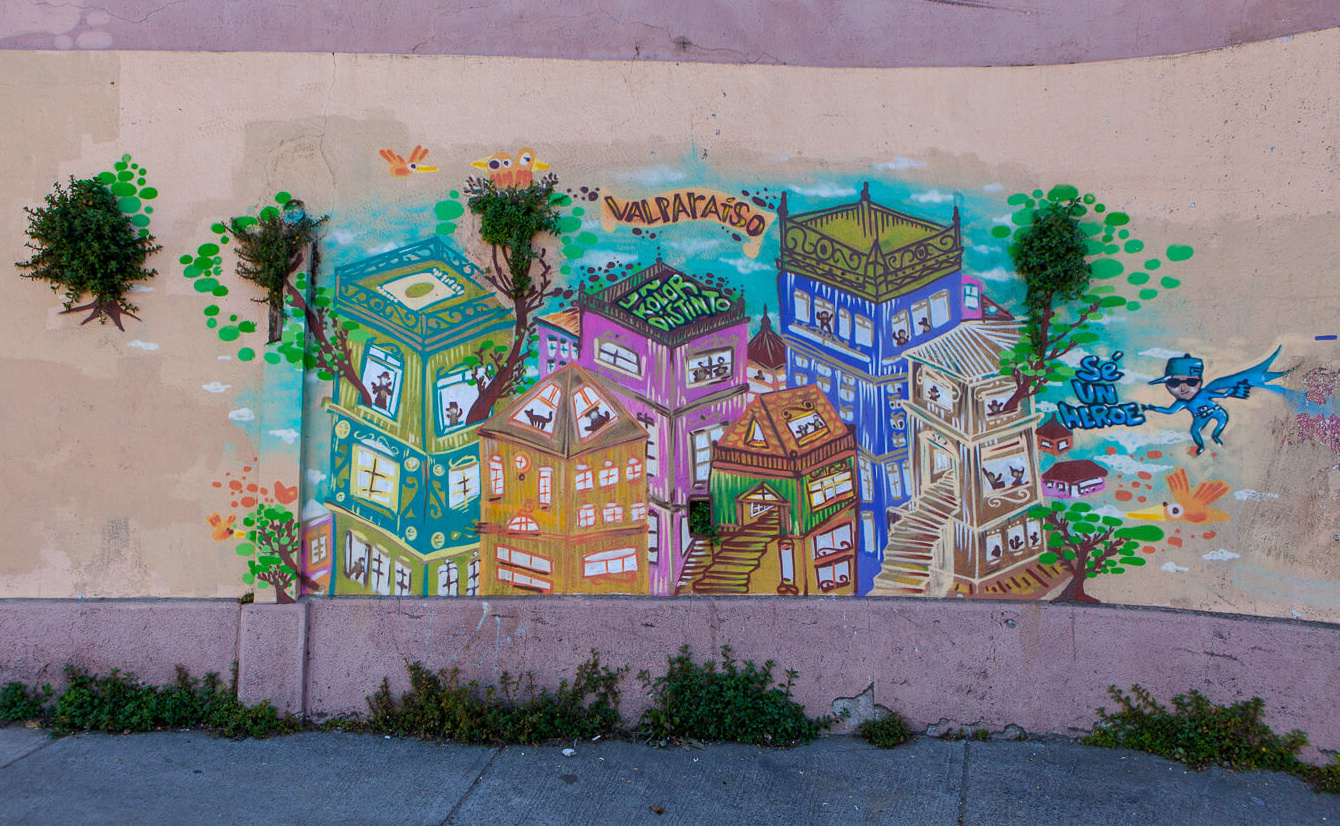Graffiti and street art are so intertwined in the identity of the port city of Valparaíso that, “if you’re coming to Valparaíso and you’re not seeing this, you’re not really getting the city.” So says Al Ramirez, who I met in an old walk up building in the “plan” part of Valpo. That is to say, the building is in the part of the city with the portside streets, which follow a grid. That’s the part got the city UNESCO recognition in 2003. It’s not up in the hilly, picturesque part of the city that earned it the nickname “Little San Francisco,” but we’ll get there later.

Al Ramirez painting a “throw-up” on the walls of Valparaiso.
We’re at his office and I want to know everything. How did someone from the same zip code as me back in Brooklyn end up here, in Valparaíso, part of the very prolific 056 crew that tags all over the city? He’s Chilean, but moved to the states when he was six. He came back for a year at fourteen after his mother died, and then he moved back to the states again. Ten years, ago, in 2006, he was traveling down through Costa Rica, Ecuador, and later into Chile.
He met woman who is now his wife, and, out of money, decided to make the most of being bilingual in a city where that’s a hot commodity. In Valparaíso he started guiding tourists straight from the bus station. Later, he moved to an agency, reading up on the city and getting to know it as he worked. He then started working with cruise ship passengers, who he says taught him a ton about customer service, and making passengers feel comfortable. “They like very Americanized things, if they don’t understand how to order a coffee, they’re going to Starbucks.”
He says this all without an iota of judgment, just like he tells the story about his own youth, calling himself a former “screwup,” saying he did a “lot of things he shouldn’t have been doing,” but that this is how he came to know the underground.

One of the many impressive murals in Valparaiso
“This is something I’ve always liked even when I was a little kid, I liked graffiti. I’ve always read it, every single tag as I walked down the street.” He started reading tags in Valparaíso, and started looking into the history of it, how graffiti connects to street art, like Banksy or other famous muralists, even home-grown favorites from Valparaíso, like INTI, who is probably the best known outside of Chile. When Al started taking people around to see the graffiti in his city, it was to explain what graffiti and street are actually communicating.
“Graffiti is the art of saying things without saying things,” Al says, listing off the the many reasons why people write on the walls, “dropping their mark.” “It’s more what it tells you about the city, there’s something wrong with it,” that they should have repainted it, and they haven’t, not like Scandinavia, where (he says) graffiti is limited to parts of the city that are known havens for drug addicts and panhandlers. Tagging all parts of the city takes that secret, hidden part and puts it out for all to see.
“It’s not about destruction, but rather about communication, a tool of the disempowered,” he tells me. “A graffiti artist says, ‘I have my weapon, which is this spray can, and my mind. I can’t go over there and sue you. I don’t have the power’.” On the walls, you can see graffiti writers in Valparaíso writing about education, about the AFP (Chile’s version of Social Security, which not everyone is happy to contribute to), what’s going on in current events, but not the same coverage you’d get on TV, Al says, indicating that the graffiti writers are free of censorship, which may not always be the case on the news.
“The graffiti writer is at the bottom of the food chain, but without the graffiti writer the rest [street art] doesn’t exist. The graffiti writer is a very simple-minded person in that sense. The graffiti writer say ‘you’re going to paint a huge beautiful wall, and I’m going to cover it up it in two minutes’.”
But before we go on, Al has to school me in what we’re even talking about. We grew up in the same streets, but I have never once thought about how to distinguish the different types of writing on the wall, never really thought about where they stop being graffiti and start becoming art.
Al briefs me on what I’ve been seeing all these years. There are tags, simple smallish lines, which may or may not be legible to passersby. Then there are throwups, two-color bubble letters, with limited detail. Make it fancy, adding stars and “power lines” and “glows”, and you’ve got a burner. More effort is a single-person work, a piece (from masterpiece), and later still, a production, a multi-person, often multi-day effort.

Al painting a “throw-up” on the wall.
All of this rolls off of Al’s tongue like yet another native language, and he peppers the conversation with more terms, interventions, stencils, collages. And that’s not the complicated part, there are rules in play in graffiti and street art in general, and specifically how things work here in Valparaíso, in terms of who can cover up whose work, and how.
There’s a strict moral code here, some of it based on history, some on connection, and some on plain old-fashioned respect. Artists and writers can gain respect in one of several ways. They can be prolific, or be part of a prolific crew, paint trains, trucks, banks, or “heaven spots” which are hard-to-reach (and hard to repaint), usually high up, and definitely not legal. That’s how you get the respect of the rest of the community, he says, both those who paint, and those simply pass by every day.
Because the paint is so much an inalienable part of the landscape, many porteños (people from Valparaíso) accept it, and even value it, especially when it’s artistic. Up on a hill far from the plan, Al was out painting one day, and a police officer asked to see his ID. Passersby started yelling at the police officer to leave him alone, saying he was beautifying the city.
Once writers and artists get that respect, even if it’s by painting illegally, that’s when things can change for those who paint. The city or individual businesses come to the artists, and ask them to do legal work, which can be lucrative, if at times a bit uncreative, Al says. Not everyone is into being asked to do that kind of work.
“That’s the biggest pain. Nobody would waste their money and their paint to paint this, because all you have to do is turn that way, and there it is,” he says, pointing to one of the very, nonpolitical (but still pretty) pieces that depict the city itself on a nearby wall, as we are walking uphill. It turns out all those beautiful pieces in Valparaíso that depict scenes from Valparaíso are commissioned.

One of the many murals of Valparaiso on the city’s walls.
We go through the turnstile to take the creaky Reina Victoria funicular up into one of the hills, to a spot Al uses to give a workshop. He sets up a temporary canvas out of industrial cling film between two supports of the walkway that runs under the elevator, and marks it with a few Xs to delineate points on what he’s about to outline.
He uses swooping motions, first describing his arc with the can in hand, but not painting anything, and then going through a second or third time, and a cartoon cat’s face appears. He does what he knows to be the more challenging parts, and then hands a can off to a guest, in town about to start a cruise to Antarctica. Black, white, yellow, blue and pink make a cat that’s half rockabilly, half Hanna-Barbera cartoons, a holdover from Al’s Brooklyn childhood. To him they represent the “happiness of planning trouble or joyful mischief.”
He’s got paints of different coverage for different parts of the face, and different caps, too, which he changes out. There are a few different techniques to master, including the flare, which is used to make a fade-out on a background, which in this case stops where the cling film ends. But he’s not trying to make it too perfect, nor does he expect the guest to be an expert. “This is graffiti, it’s dirty, the symmetry is not perfect, it has the drip, when it’s too clean and too perfect… the people in the community don’t like it,” he says, cleaning up a few places where the guest went outside the lines, and topping it off with a couple of simple white asterisk-type-stars.
When they’re done with the cat, after a few photos, Al pulls it down, and it goes in the trash. It’s art, but like much of the work here in Valparaíso, it’s transitory.
Al deals with this impermanence as easily as he straddles the two worlds he occupies: Brooklynite, porteño businessman, and he’s even studied at the sommelier school in Santiago. But in the end, he’s a grafitero. “Even if they gave me 1,000 legal walls, I still wouldn’t stop writing on the street, because that’s how I get my rep,” he tells me. Because graffiti is not just his business, it’s an important part of his identity.
Related Experiences:
Want to get to know the street art culture for yourself and try your hand at graffiti? We’ve got you covered.

